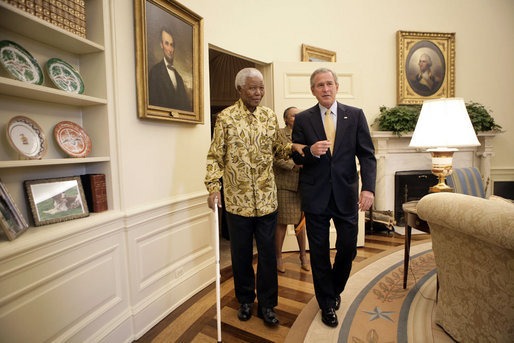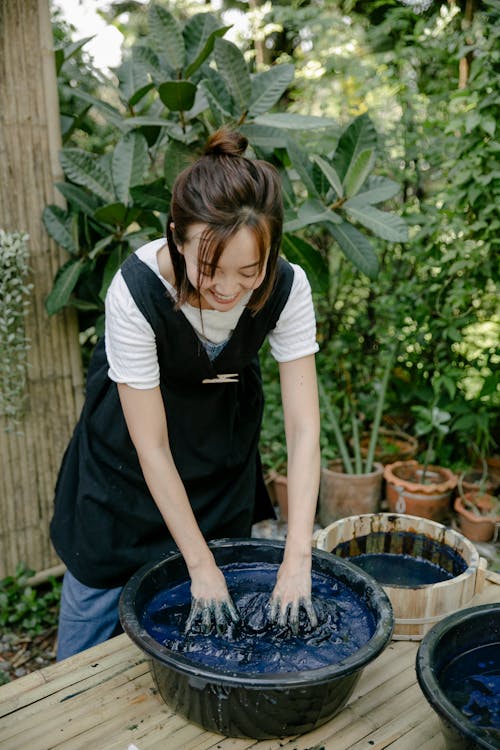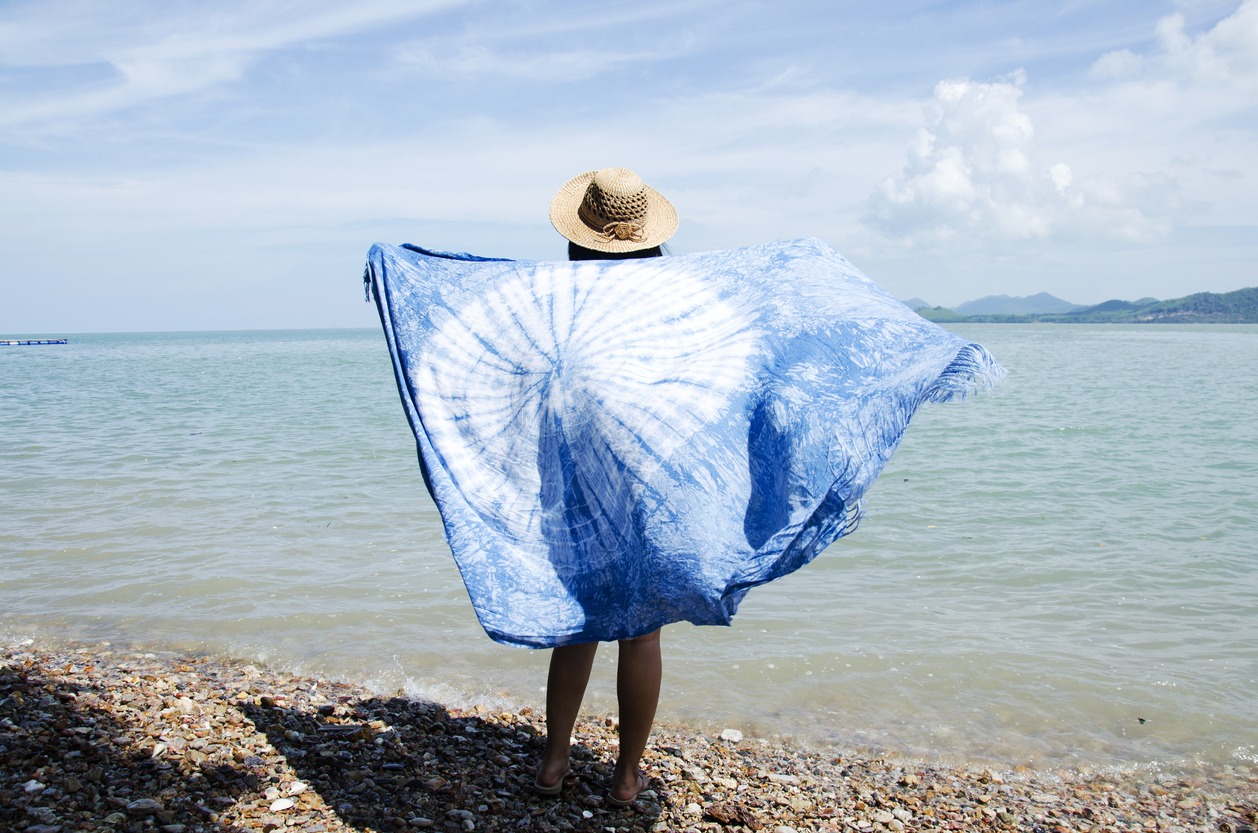In the 1960s, tie-dye emerged as a vibrant emblem of self-expression and nonconformity, closely intertwined with the counterculture movement. Originally a centuries-old technique practiced across the world, it was adopted and reinvented by the American youth who were challenging the cultural and social norms of the time. This renaissance of tie-dye was more than just a fashion statement; it was a visual representation of the era’s desire for individuality and liberation from the rigid societal structures of the past.
The spontaneous and colorful patterns of tie-dye became synonymous with the freedom and revolutionary spirit of the 1960s. Each piece was unique, with swirls of color that captured the essence of the do-it-yourself (DIY) attitude prevalent among the youth of the era. By using simple materials like Rit dyes, which were readily available and easy to use, people could create personalized garments that stood in stark contrast to the manufactured conformity of the 1950s.
As tie-dye clothing gained popularity, it was quickly embraced by the masses, including prominent figures and musicians who wore these creations, further cementing its status within the fashion world and beyond. The trend reflected the broader changes sweeping across society, from the music scene to political protests, making tie-dye an enduring symbol of the decade’s transformative energy.
Historical Context and Origins
Tie-dye’s vibrant patterns are not just relics of 1960s America; their roots extend into ancient civilizations, showcasing a long history of textile art before their association with the American counterculture movement.

Tie-Dye in Ancient Cultures
Ancient techniques of tie-dye, known across different cultures, involved twisting, binding, and folding fabric to create intricate designs once dyed. Shibori, a Japanese method of resist dyeing, traces back to the 8th century and involves a range of techniques from crumpling to stitching for pattern creation. Similarly, in India, bandhani—a term that originates from the Sanskrit word for “to bind”—has been a tradition for over 4,000 years. This painstaking craft requires plucking the cloth with the fingernails into many tiny bindings before dyeing.
China and Indonesia also developed their own dyeing traditions, with China influencing the spread of the art through the famous Silk Road. Indonesia is renowned for batik, a technique that uses wax-resist dyeing to create patterns. Often, natural dyes were extracted from plants and other organic materials, which not only provided a rich palette of colors but also established dyeing as an ecological art form deeply intertwined with local resources and traditions.
Revival in 1960s America
In the 1960s, America saw a resurgence of tie-dye, not as a method of textile creation but as a symbol of the counterculture movement. Unlike the ancient artisanal methods, the modern approach to tie-dye associated with hippies was readily available and DIY in nature. The spontaneity in patterns paralleled the movement’s values of individuality and nonconformity. As a form of self-expression, tie-dye became emblematic of the era’s ethos—peace, love, and freedom. It signified a rebellion against the uniformity of mass-produced clothing, embracing instead a homemade aesthetic that fiercely represented personal identity and collective solidarity within the American counterculture.
Cultural and Symbolic Significance
Tie-dye in the 1960s emerged as a vibrant emblem of defiance and individuality. It transcended simple fashion to become a visual manifesto of the era’s transformative ethos.
Counterculture and Anti-War Movement
Referenced as a symbol of the counterculture, tie-dye shirts became a canvas for expressing anti-war sentiments and a desire for peace. During protests against the Vietnam War, tie-dye shirts often bore peace signs and became associated with iconic music festivals like Woodstock. Influential musicians such as Jimi Hendrix, Janis Joplin, and bands like The Grateful Dead donned tie-dye, cementing its standing as a countercultural symbol. The bright colors and patterns were akin to wearing one’s political and pacifistic ideologies.
- Woodstock and Tie-Dye: The 1969 music festival was a high watermark for tie-dye in the public consciousness, interweaving music, anti-war protest, and visual expression.
- Musicians and Bands: Artists like Jimi Hendrix and Janis Joplin became unintentional style-icons for the movement, often seen in tie-dye attire during performances.
Fashion as a Form of Self-Expression
Tie-dye became a medium of self-expression in the 1960s, reflecting anti-materialism and a break from conformity. Each piece was unique, embracing flaws and irregularities, which resonated with the hippie movement’s values. Patterns such as the mandala were popular for their spiritual symbolism, but it was the literal and figurative blending of colors that suggested an ideology: a harmonious society free from segregation and inequality.
- Patterns and Meanings: Common patterns included spirals, concentric circles, and peace signs, all infused with symbolism.
- Individualism: The process of creating tie-dye was as significant as the end product, embodying a hands-on approach to personal style and creativity.
Tie-Dye Techniques and Materials
The art of tie-dye traditionally utilizes a variety of techniques and materials to produce colorful patterns on fabric. Distinctive methods like folding and binding the textile play a crucial role in resist dyeing processes, and the choice of dyes and textiles impacts the vibrancy and longevity of the designs.
Traditional Dyeing Methods
Historical roots: Traditional tie-dye methods have been established for millennia, with ancient practices such as Japanese shibori and Indian bandhani utilizing resist dyeing techniques. These methods involve manipulating the fabric through folding, twisting, pleating, or crumpling, followed by tightly tying it with string or rubber bands. The tied areas resist the dye, creating intricate patterns once the bindings are removed.
- Fabric selection: Natural fibers like cotton, silk, or wool were ideal for absorbing natural dyes, with indigo being a prominent choice due to its vibrant hue and colorfastness.
- Binding materials: Items such as string, rubber bands, and even wooden blocks were employed to secure the fabric in place, affecting the resultant dye patterns.
Innovations in Tie-Dye
In the 1960s, tie-dye became emblematic of self-expression and creativity in American culture. The availability of synthetic dyes, such as those made by Rit, marked a significant advancement. These dyes were formulated for compatibility with diverse textile types and were often used in household tie-dyeing endeavors.
- Dye variety: Rit and similar synthetic dyes offered a spectrum of colors, which, although not as colorfast as traditional dyes like indigo, significantly expanded the palette for artists and hobbyists.
- Technique evolution: The period saw innovation in tie-dye techniques, with more individuals experimenting freely with folding patterns and binding methods, leading to the wide array of designs characteristic of the era.
The use of accessible materials, combined with the innovative spirit of the 1960s, allowed individuals to explore tie-dyeing with remarkable creativity. Despite the variations in methods and materials across cultures and time periods, the essence of tie-dye has continuously been defined by the imaginative use of resist dyeing techniques and the vivid colors imparted by various dyes.
Tie-Dye in Modern Fashion
Tie-dye has traversed from a symbol of rebellion to mainstream fashion chic, witnessing a resurgence that marries traditional techniques with modern ethical sensibilities and design innovations.
From Runways to DIY
Designers have reintroduced tie-dye in mainstream fashion, with the technique gracing runways across the world. It has been reimagined in luxurious fabrics such as silk, cotton, linen, and hemp, showcasing how a humble ’70s trend can evolve into high fashion. The appeal for DIY tie-dye has also escalated, with individuals seeking personalized garments. It represents a blend of travel-inspired patterns and local designs, where anyone can create their own bespoke piece of clothing, making it truly unique.
Sustainability and Innovation
Sustainability plays a key role in modern tie-dye practices. There is a growing use of natural dyes and eco-friendly materials to produce garments that are kinder to the environment. The palette of colors available has expanded due to advancements in dye technology, allowing for a more vibrant variety of hues that maintain their brilliance over time. Furthermore, sustainable garment production emphasizes mindful consumption, with tie-dye becoming a method to give new life to existing clothes, thus reducing waste.
Legacies and Continued Influence
Tie-dye as a fashion phenomenon is intrinsically linked to the hippie movement of the 1960s. Its vibrant patterns symbolized a break from conventional norms, emphasizing individuality and a departure from the conformist 1950s. The trend became synonymous with San Francisco’s Haight-Ashbury district, a hotspot for the counterculture. Here, figures like Ken Kesey and psychedelic experiences associated with LSD bolstered a community rallying for freedom and unrest against the backdrop of the Vietnam War.
The influence of tie-dye extended beyond clothing, representing a visual language for counterculture movements. It transcended simple fashion to become an emblem of peaceful defiance. The trend dipped in the decades that followed but has seen revivals, especially in haute couture, as designers often hark back to the freedom and radical expression it epitomized.
In recent years, tie-dye has re-emerged as a symbol of artisanal and eco-friendly fashion. It is not unusual to spot tie-dye at music festivals and in current streetwear, carrying forward its heritage of nonconformity and socio-political commentary.
- Key Influences and Symbols
- Individuality: Custom patterns ensure no two tie-dye items are alike.
- Hippie Movement: Tie-dye became a uniform for peace and love advocacies.
- San Francisco: The city’s creative melting pot played a pivotal role in tie-dye’s popularity.
- Ken Kesey: His Merry Pranksters’ bus journey unified countercultures nationwide.
- Drug Use: Psychedelics like LSD inspired the vibrant, swirling designs.
The legacy of 1960s tie-dye is a testament to its enduring appeal and its sustained narrative as an artistic form of cultural and political expression.
Global Impact and Cross-Cultural Exchanges
The 1960s tie-dye witnessed a resurgence which underscores a complex tapestry of cultural exchanges and global influences, featuring a dialogue between ancient techniques and modern expressions.
Tie-Dye Across the World
In India, the art of bandhani, a term that derives from the Sanskrit word bandh, meaning “to tie,” has been evident in textiles for centuries. This method involves intricate tying and dyeing processes, producing patterns that have been synonymous with South Asian culture.
Moving to Japan, the practice known as shibori, which includes a range of techniques that involve folding, twisting, and binding fabric before dyeing, contributes another historical layer to tie-dye’s global journey. Shibori is revered for its range of delicate patterns.
West Africa has its own rich history with tie-dye, where indigo dyeing has been particularly prominent in the Hausa region, most notably in Kano, Nigeria. The region’s traditional methods have produced textiles with vibrant patterns, which became an important part of its cultural identity and economy.
As these traditional practices traveled, they intersected with the 20th-century arts and crafts movements, including the counterculture movement of the 1960s in North America, which embraced tie-dye as a form of self-expression and rebellion. The adoption of tie-dye during this era was not just a fashion statement but also a nod to a global connectivity, influenced by the increased capacity for travel and cultural exchange.
Textile trade saw the use of Rit dye, an accessible dye product, which played a pivotal role in the DIY culture surrounding tie-dye, making it a household activity as well as a craft. This accessibility helped propagate the method across different demographics and regions during the 1960s and still resonates in the trade of tie-dye garments today.
In countries like Peru, the impact of global trade, and the Great Depression, influenced local textile production, which in turn fed back into the global appreciation of tie-dye and similar techniques.
This global exchange not only shaped the identity of fabrics but also signaled a broader exchange of ideas and values, illustrating how a single craft technique can weave together disparate cultures through shared artistic expression.





